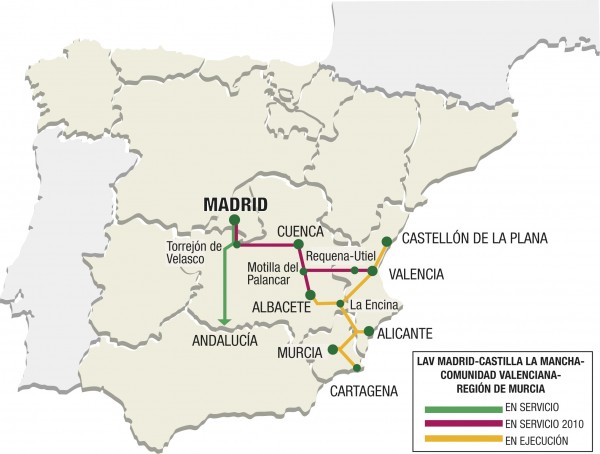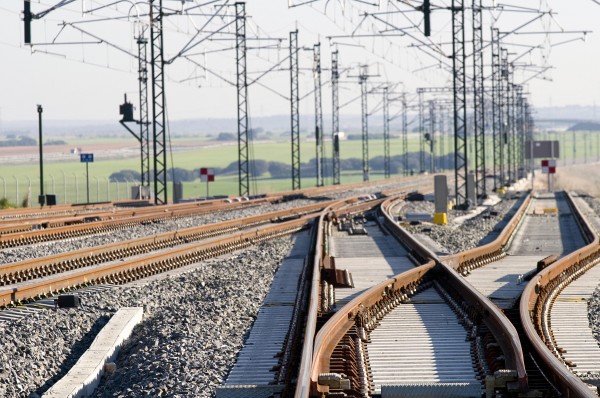Progress on the Madrid–Levante high-speed line
Posted: 17 September 2010 | | No comments yet
The Madrid–Castilla La Mancha–Comunidad Valenciana-Región de Murcia high-speed line is one of the greatest works in Spanish and the world’s civil engineering history, both for its length – 955km – and for the new technologies applied in its construction.
This line, in which €12.4 million have been invested, is one of the most important high-speed corridors in the Iberian Peninsula. The eastern region of the Iberian Peninsula is also known as the Levante region. Its route begins in the Madrid Puerta de Atocha station. It shares 29km with the currently operative Madrid–Seville/Málaga line, which is being split to achieve independent accesses for both lines.
The Madrid–Castilla La Mancha–Comunidad Valenciana-Región de Murcia high-speed line is one of the greatest works in Spanish and the world’s civil engineering history, both for its length – 955km – and for the new technologies applied in its construction. This line, in which €12.4 million have been invested, is one of the most important high-speed corridors in the Iberian Peninsula. The eastern region of the Iberian Peninsula is also known as the Levante region. Its route begins in the Madrid Puerta de Atocha station. It shares 29km with the currently operative Madrid–Seville/Málaga line, which is being split to achieve independent accesses for both lines.
The Madrid–Castilla La Mancha–Comunidad Valenciana-Región de Murcia high-speed line is one of the greatest works in Spanish and the world’s civil engineering history, both for its length – 955km – and for the new technologies applied in its construction.
This line, in which €12.4 million have been invested, is one of the most important high-speed corridors in the Iberian Peninsula. The eastern region of the Iberian Peninsula is also known as the Levante region. Its route begins in the Madrid Puerta de Atocha station. It shares 29km with the currently operative Madrid–Seville/Málaga line, which is being split to achieve independent accesses for both lines. It continues through Cuenca up to the Motilla del Palancar (167.5km) junction and heads directly towards Valencia/Castellón through one branch, and to Albacete/Alicante/Murcia through the other.
In this way, high-speed interconnection is achieved between the provinces of Madrid, Cuenca, Albacete, Valencia, Alicante, Castellón and Murcia. In addition to the direct Madrid–Cuenca–Valencia branch, the cities of Murcia and Alicante, for example, can communicate between them through high-speed, with the Albacete–Cuenca–Madrid section and with Valencia–Castellón, thanks to the La Encina junction. A meshed network that enables the interchange between all the province capitals of the new high-speed line.
The start of the Madrid–Castilla La Mancha–Comunidad Valenciana-Región de Murcia high-speed line dates back to 17 September 1999, when the Spanish Government, by means of a Council of Ministers agreement, committed its construction and management. However, the works of the Madrid–Valencia direct corridor did not begin until March 2004, when the first stone was placed in the Requena–Siete Aguas (Valencia) section.
The direct Madrid–Cuenca–Valencia y Madrid–Cuenca–Albacete connections will be in service by the end of 2010, with the resulting improvement in safety and comfort during the journeys and important journey time reductions between these cities.


A map of the high-speed route
Advanced and cutting edge engineering
Construction of the high-speed line to the Levante region has been executed with the most advanced technology in order to increase comfort, due to optimum rail surface conditions; an increase in safety, due to the use of cutting edge technology in the trains’ automatic driving systems and the absence of level crossings throughout the line, and a reduction of journey times between the connected cities as direct connections between them are possible.
As with the rest of the high-speed lines, the section is built as a UIC European double gauge track (1,435mm) to circumvent the historic European connection problems of the Iberian width railway (1,668mm).
This infrastructure has been a real challenge for railway and civil engineering. Tunnels and viaducts have overcome an irregular and different orography as this highspeed line crosses four autonomous regions.
One of the maxims that have imbued the construction of this great infrastructure has been environmental protection. The Regajal tunnel (2,347m) is an example of this, both for its difficult execution from the geological and geotechnical point-of-view, and for the environmental value of the area in which it is located, near the Mar de Ontígola, a wetland located in the El Regajal Nature Reserve (Toledo).
Infrastructure works have also been a great satisfaction for the companies, operators and engineers that have taken part in the construction of the line. This is the case if the Contreras viaduct (587m) that joins its beauty and plasticity to the fact that it is the one with the largest concrete arch in the European railway network.
The most complex part of the work has been the execution of the arch, with a span of 261m and a maximum height of 37m. The construction of the arch and of the upper deck, on which the railway line is located, advanced simultaneously in a way that placing the deck enabled the advance of the arch itself.
In this sense, we must also highlight the La Cabrera tunnel, the longest in the highspeed line to the Levante region at 7,250m. Located between Siete Aguas and Buñol (Valencia), during its construction (in an approximately 10-month term) the daily tunnel boring machine perforation advance world record was beaten seven times, with the record being established at 92.8m excavated and 58 concrete rings placed. A 204m 2,700-tonne tunnel boring machine was used during its perforation.
The Contreras viaduct, an example of engineering with environmental protection in mind
With a length of 587.2m and a platform width of 14m on which an international double gauge high-speed track has been installed, its singularity resides both in its stylised design, that favours its integration in the environment, and in the applied construction technique. The Contreras viaduct is flanked by the west exit of the Rabo de la Sartén tunnel on one side and by the Cuesta Negra viaduct on the other side. To man’s contribution of great beauty of design and excellent engineering, nature’s contribution to the Contreras viaduct is an exceptional landscape location, near the gorges of the Cabriel river.
Due to its location in protected environmental surroundings, Adif has taken exceptional measures, both with regards to the construction project and during the execution of the works, taking into account the existing environmental corridors as well as the birds’ nesting periods.


The high-speed line Madrid–Levante is 955km-long
Stations and urban integration
Modern, accessible and efficient are the characteristics that define the eight new high-speed stations. Four stations are currently being built in the cities of Cuenca, Albacete, Requena-Utiel and Valencia, and the one in Xátiva is being refurbished. All the terminals are sized for the expected traffic according to its sphere of influence.
Albacete station was built under the Vialia concept, where, in addition to the railway services designed for high-speed stations, a centre is created that will promote leisure, commerce and culture in this city.
In Valencia, Adif has built a station provided with all the constructive and comfort parameters to host the clients from future high-speed trains. Due to its conception (it will provide service until the new Central Station is executed) it has been built with materials that can be reused in the future.
The Requena-Utiel station was designed to favour rational use of energy. For this, energy efficiency, thermal insulation and energy saving criteria have been taken into account, so it will include thermal solar panels to produce hot water and photovoltaic panels to receive solar energy and transform it into electrical energy.
The construction of high-speed stations is also scheduled in Almansa, Murcia, Alicante, Elche and Villena. Achieving fast and competitive connections between cities is one of the main objectives of high-speed, but the integration of railway in a city through the railway network and the new stations is not less important.
Tunnelling the tracks in the cities of Valencia, Alicante and Murcia will facilitate the creation of a new green areas for these cities and the improvement of railway traffic, not only for high-speed, but also for the suburban train service. A revolution in the cities’ urban planning.
In order to carry out this urban planning, railway integration companies have been established in which, besides Adif and Renfe, the three administrations participate: The Ministry of Public Works, the Autonomous Region and the respective city halls.
In Valencia, railway projects entail tunnelling the railway through the city, which will allow for the creation of a Central Park, a new Central station next to the current Valencia Nord and another two terminals for suburban trains located in the transit tunnel, which will connect high-speed and suburban trains with Castellon and the Mediterranean Corridor.
The projects address a situation similar to that of the cities of Alicante and Murcia, where the tracks will disappear from the surface, in the future, to give way to new urban areas and modern and accessible stations.
Investment effort
The scheduled investment of the high-speed Madrid–Castilla La Mancha–Comunidad Valenciana-Región de Murcia line is €12.410 million and is a real driving force for the regional economies where the route passes and is an effort which has been taken on by Adif, the Ministry of Public Works and the European Union (through investment of European Funds). In this sense, we must emphasise that the studies and projects of the new line, as well as the construction of the platform of several subsections, have been co-financed by TEN-T Funds (Trans-European Transport Network).
In the 2000-2006 Community Support Framework, the total funds granted by the European Union to the new high-speed line reached €575 million from the Cohesion Fund, €125 million from the European Regional Development Fund (ERDF), and €48 million from TEN-T funds.
For the 2007-2013 period, part of the lines platform is co-financed with €726 million from the Cohesion Fund, within the Operational Programme ‘Cohesion Fund – ERDF 2007-2013’. Likewise, the provision and assembly of tracks and the facilities will be co-financed by the ERDF, through Operational Programmes ‘Castilla–La Mancha 2007-2013 and Comunidad Valenciana 2007-2013’. Several high-speed projects will also be co-financed by the ERDF, through the Operational Programme ‘Murcia 2007-2013’.
The European Investment Bank also participates in co-financing the high-speed line through long-term credit operations.








